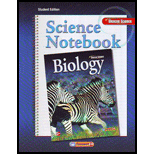
To describe:
The given features of lancelets.
Introduction: Invertebrate chordateshave features linking them to vertebrate chordates. Invertebrate chordates belong to either of the two subphyla of chordates- Cephalochordata and Urochordata, have a dorsal a dorsal tubular nerve cord, a notochord, pharyngeal pouches, a postanal tail and possibly an ancestral thyroid gland but no backbone. They resemble echinoderms in being deuterostomes.
Answer to Problem 6MI
| Phylum: Chordata | Subphylum: Cephalochordata |
| Skin: lacks color and scales; body structures visible through skin. | |
| Feeding method: filter feeders; digestion in stomach like structure. | |
| Movement: segmented muscle blocks enable fishlike swimming. | |
| Sensory structures: light receptors and small sensory tentacles near mouth. | |
| Blood circulation: pumping action of blood vessels; no heart. | |
Explanation of Solution
Lancelet is an invertebrate chordate belonging to the phylum Chordata and subphylum Cephalochordata. It is an eel like animal, also called amphioxus, and lives buried in sand. It has a fish shaped translucent body. The skin lacks scales and color due to which one can see the internal organs and functions clearly. With its headless body half buried in sand, lancelet filter feeds. Water enters the mouth of the lancelet and passes through the pharyngeal gill slits. Food is trapped on to a stomach like structure to be digested. Water leaves the body through the gill slits.
Blood is circulated throughout the body by pumping action of blood vessels carrying the food throughout the body. However, there is no heart and red blood cells. Lancelets swim like fish with the help of segmented muscular blocks. Light receptors and small sensory tentacles are located near mouth which helps them to locate things.
Additional Science Textbook Solutions
Campbell Essential Biology (7th Edition)
Microbiology with Diseases by Body System (4th Edition)
Campbell Biology: Concepts & Connections (9th Edition)
Laboratory Experiments in Microbiology (11th Edition)
Campbell Biology (10th Edition)
 Human Anatomy & Physiology (11th Edition)BiologyISBN:9780134580999Author:Elaine N. Marieb, Katja N. HoehnPublisher:PEARSON
Human Anatomy & Physiology (11th Edition)BiologyISBN:9780134580999Author:Elaine N. Marieb, Katja N. HoehnPublisher:PEARSON Biology 2eBiologyISBN:9781947172517Author:Matthew Douglas, Jung Choi, Mary Ann ClarkPublisher:OpenStax
Biology 2eBiologyISBN:9781947172517Author:Matthew Douglas, Jung Choi, Mary Ann ClarkPublisher:OpenStax Anatomy & PhysiologyBiologyISBN:9781259398629Author:McKinley, Michael P., O'loughlin, Valerie Dean, Bidle, Theresa StouterPublisher:Mcgraw Hill Education,
Anatomy & PhysiologyBiologyISBN:9781259398629Author:McKinley, Michael P., O'loughlin, Valerie Dean, Bidle, Theresa StouterPublisher:Mcgraw Hill Education, Molecular Biology of the Cell (Sixth Edition)BiologyISBN:9780815344322Author:Bruce Alberts, Alexander D. Johnson, Julian Lewis, David Morgan, Martin Raff, Keith Roberts, Peter WalterPublisher:W. W. Norton & Company
Molecular Biology of the Cell (Sixth Edition)BiologyISBN:9780815344322Author:Bruce Alberts, Alexander D. Johnson, Julian Lewis, David Morgan, Martin Raff, Keith Roberts, Peter WalterPublisher:W. W. Norton & Company Laboratory Manual For Human Anatomy & PhysiologyBiologyISBN:9781260159363Author:Martin, Terry R., Prentice-craver, CynthiaPublisher:McGraw-Hill Publishing Co.
Laboratory Manual For Human Anatomy & PhysiologyBiologyISBN:9781260159363Author:Martin, Terry R., Prentice-craver, CynthiaPublisher:McGraw-Hill Publishing Co. Inquiry Into Life (16th Edition)BiologyISBN:9781260231700Author:Sylvia S. Mader, Michael WindelspechtPublisher:McGraw Hill Education
Inquiry Into Life (16th Edition)BiologyISBN:9781260231700Author:Sylvia S. Mader, Michael WindelspechtPublisher:McGraw Hill Education





